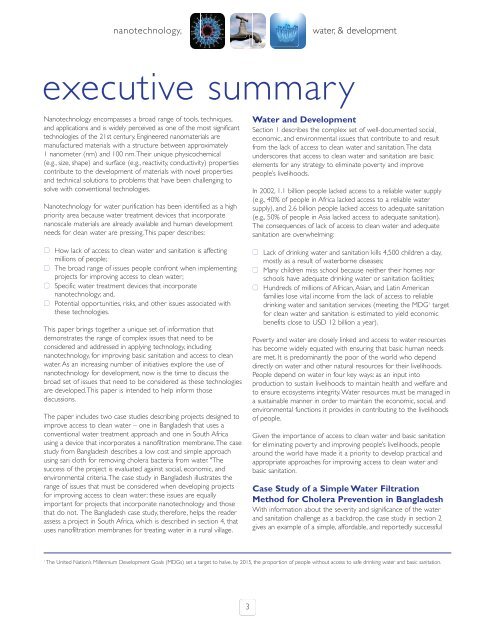Global Dialogue on Nanotechnology and the Poor ... - Nanowerk
Global Dialogue on Nanotechnology and the Poor ... - Nanowerk
Global Dialogue on Nanotechnology and the Poor ... - Nanowerk
You also want an ePaper? Increase the reach of your titles
YUMPU automatically turns print PDFs into web optimized ePapers that Google loves.
nanotechnology,<br />
water, & development<br />
executive summary<br />
<strong>Nanotechnology</strong> encompasses a broad range of tools, techniques,<br />
<strong>and</strong> applicati<strong>on</strong>s <strong>and</strong> is widely perceived as <strong>on</strong>e of <strong>the</strong> most significant<br />
technologies of <strong>the</strong> 21st century. Engineered nanomaterials are<br />
manufactured materials with a structure between approximately<br />
1 nanometer (nm) <strong>and</strong> 100 nm.Their unique physicochemical<br />
(e.g., size, shape) <strong>and</strong> surface (e.g., reactivity, c<strong>on</strong>ductivity) properties<br />
c<strong>on</strong>tribute to <strong>the</strong> development of materials with novel properties<br />
<strong>and</strong> technical soluti<strong>on</strong>s to problems that have been challenging to<br />
solve with c<strong>on</strong>venti<strong>on</strong>al technologies.<br />
<strong>Nanotechnology</strong> for water purificati<strong>on</strong> has been identified as a high<br />
priority area because water treatment devices that incorporate<br />
nanoscale materials are already available <strong>and</strong> human development<br />
needs for clean water are pressing.This paper describes:<br />
How lack of access to clean water <strong>and</strong> sanitati<strong>on</strong> is affecting<br />
milli<strong>on</strong>s of people;<br />
The broad range of issues people c<strong>on</strong>fr<strong>on</strong>t when implementing<br />
projects for improving access to clean water;<br />
Specific water treatment devices that incorporate<br />
nanotechnology; <strong>and</strong>,<br />
Potential opportunities, risks, <strong>and</strong> o<strong>the</strong>r issues associated with<br />
<strong>the</strong>se technologies.<br />
This paper brings toge<strong>the</strong>r a unique set of informati<strong>on</strong> that<br />
dem<strong>on</strong>strates <strong>the</strong> range of complex issues that need to be<br />
c<strong>on</strong>sidered <strong>and</strong> addressed in applying technology, including<br />
nanotechnology, for improving basic sanitati<strong>on</strong> <strong>and</strong> access to clean<br />
water. As an increasing number of initiatives explore <strong>the</strong> use of<br />
nanotechnology for development, now is <strong>the</strong> time to discuss <strong>the</strong><br />
broad set of issues that need to be c<strong>on</strong>sidered as <strong>the</strong>se technologies<br />
are developed.This paper is intended to help inform those<br />
discussi<strong>on</strong>s.<br />
The paper includes two case studies describing projects designed to<br />
improve access to clean water – <strong>on</strong>e in Bangladesh that uses a<br />
c<strong>on</strong>venti<strong>on</strong>al water treatment approach <strong>and</strong> <strong>on</strong>e in South Africa<br />
using a device that incorporates a nanofiltrati<strong>on</strong> membrane.The case<br />
study from Bangladesh describes a low cost <strong>and</strong> simple approach<br />
using sari cloth for removing cholera bacteria from water. "The<br />
success of <strong>the</strong> project is evaluated against social, ec<strong>on</strong>omic, <strong>and</strong><br />
envir<strong>on</strong>mental criteria.The case study in Bangladesh illustrates <strong>the</strong><br />
range of issues that must be c<strong>on</strong>sidered when developing projects<br />
for improving access to clean water; <strong>the</strong>se issues are equally<br />
important for projects that incorporate nanotechnology <strong>and</strong> those<br />
that do not. The Bangladesh case study, <strong>the</strong>refore, helps <strong>the</strong> reader<br />
assess a project in South Africa, which is described in secti<strong>on</strong> 4, that<br />
uses nanofiltrati<strong>on</strong> membranes for treating water in a rural village.<br />
Water <strong>and</strong> Development<br />
Secti<strong>on</strong> 1 describes <strong>the</strong> complex set of well-documented social,<br />
ec<strong>on</strong>omic, <strong>and</strong> envir<strong>on</strong>mental issues that c<strong>on</strong>tribute to <strong>and</strong> result<br />
from <strong>the</strong> lack of access to clean water <strong>and</strong> sanitati<strong>on</strong>.The data<br />
underscores that access to clean water <strong>and</strong> sanitati<strong>on</strong> are basic<br />
elements for any strategy to eliminate poverty <strong>and</strong> improve<br />
people’s livelihoods.<br />
In 2002, 1.1 billi<strong>on</strong> people lacked access to a reliable water supply<br />
(e.g., 40% of people in Africa lacked access to a reliable water<br />
supply), <strong>and</strong> 2.6 billi<strong>on</strong> people lacked access to adequate sanitati<strong>on</strong><br />
(e.g., 50% of people in Asia lacked access to adequate sanitati<strong>on</strong>).<br />
The c<strong>on</strong>sequences of lack of access to clean water <strong>and</strong> adequate<br />
sanitati<strong>on</strong> are overwhelming:<br />
Lack of drinking water <strong>and</strong> sanitati<strong>on</strong> kills 4,500 children a day,<br />
mostly as a result of waterborne diseases;<br />
Many children miss school because nei<strong>the</strong>r <strong>the</strong>ir homes nor<br />
schools have adequate drinking water or sanitati<strong>on</strong> facilities;<br />
Hundreds of milli<strong>on</strong>s of African, Asian, <strong>and</strong> Latin American<br />
families lose vital income from <strong>the</strong> lack of access to reliable<br />
drinking water <strong>and</strong> sanitati<strong>on</strong> services (meeting <strong>the</strong> MDG 1 target<br />
for clean water <strong>and</strong> sanitati<strong>on</strong> is estimated to yield ec<strong>on</strong>omic<br />
benefits close to USD 12 billi<strong>on</strong> a year).<br />
Poverty <strong>and</strong> water are closely linked <strong>and</strong> access to water resources<br />
has become widely equated with ensuring that basic human needs<br />
are met. It is predominantly <strong>the</strong> poor of <strong>the</strong> world who depend<br />
directly <strong>on</strong> water <strong>and</strong> o<strong>the</strong>r natural resources for <strong>the</strong>ir livelihoods.<br />
People depend <strong>on</strong> water in four key ways: as an input into<br />
producti<strong>on</strong> to sustain livelihoods to maintain health <strong>and</strong> welfare <strong>and</strong><br />
to ensure ecosystems integrity.Water resources must be managed in<br />
a sustainable manner in order to maintain <strong>the</strong> ec<strong>on</strong>omic, social, <strong>and</strong><br />
envir<strong>on</strong>mental functi<strong>on</strong>s it provides in c<strong>on</strong>tributing to <strong>the</strong> livelihoods<br />
of people.<br />
Given <strong>the</strong> importance of access to clean water <strong>and</strong> basic sanitati<strong>on</strong><br />
for eliminating poverty <strong>and</strong> improving people’s livelihoods, people<br />
around <strong>the</strong> world have made it a priority to develop practical <strong>and</strong><br />
appropriate approaches for improving access to clean water <strong>and</strong><br />
basic sanitati<strong>on</strong>.<br />
Case Study of a Simple Water Filtrati<strong>on</strong><br />
Method for Cholera Preventi<strong>on</strong> in Bangladesh<br />
With informati<strong>on</strong> about <strong>the</strong> severity <strong>and</strong> significance of <strong>the</strong> water<br />
<strong>and</strong> sanitati<strong>on</strong> challenge as a backdrop, <strong>the</strong> case study in secti<strong>on</strong> 2<br />
gives an example of a simple, affordable, <strong>and</strong> reportedly successful<br />
1<br />
The United Nati<strong>on</strong>’s Millennium Development Goals (MDGs) set a target to halve, by 2015, <strong>the</strong> proporti<strong>on</strong> of people without access to safe drinking water <strong>and</strong> basic sanitati<strong>on</strong>.<br />
3
















